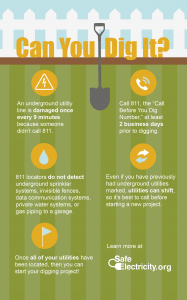
What Lurks Under the Dirt: Call Before You Dig
Instead of hitting pay dirt, you will pay if you hit an underground line
If you don’t take the time to call before you dig, you could become the person who digs in an unmarked yard and strikes an underground line every nine minutes. No one wants to be that person.
The long version of the 1971 song American Pie is almost 9 minutes long. That means if the song was played in a loop with a pause in between, a person would hit an underground line each time the song replayed. Every nine minutes, a person would be saying (or singing), “Bye-bye (Miss American Pie)" to some hard-earned cash. Fines aside, digging without knowing what is below the dirt could cause serious injury or a power outage.
People are tempted to skip calling in advance because they think striking a buried line will not happen to them. They assume that they will ‘not dig too deep’ or that they will ‘be careful.’ However, underground lines are unyielding. Their path is unpredictable and hitting one can happen with one strike of a shovel or other tool.
“You might think you are just installing a mailbox or just using a post-hole digger or planting only a small flower bed” says Erin Hollinshead, executive director of Safe Electricity. “However, underground utility lines could be anywhere, and they also shift over time. They should always be marked in advance because some can be found only a few inches below the surface.”
Kevin Chmura, director of public relations for Illinois’ one-call notification service JULIE, Inc., agrees. “Protect yourself and your family. Striking a single buried utility line can cause injury, repair costs, penalties and inconvenient outages,” he says. Every project, big or small, requires advance notification to 811. To start the underground utility marking process, call 811 or go to your state’s own 811 center website.
According to Chmura, examples of projects that require utility location include putting up a fence, installing a mailbox post, building a deck or patio, and planting trees and shrubs; however, this is not an all-inclusive list. Any project that breaks ground requires that underground utilities be marked.
After submitting a request, underground lines will be marked by their respective utilities; however, locators do not mark private lines such as service to outbuildings, underground sprinkler systems or a gas line to a grill, for example. Private lines are the responsibility of the homeowner.
If you are only digging in a small area of your yard, you can outline the area in white spray paint or with white flags to ensure that only that part of your yard will be located and marked. (White flags are available at home improvement stores.)
There are five steps to safer digging:
1. Pre-mark the proposed dig area with white paint or flags.
2. Call 811 or go online to submit your locate request before you dig. There is no charge for the service.
3. Wait the required amount of time (typically two business days).
4. Respect the marks and do not move any flags.
5. Dig with care. Avoid digging on top of or within 18–24 inches on all sides of utility marks, which may mean moving your digging project to another part of your yard.
For more information about electrical safety, visit SafeElectricity.org. For more information about 811, visit call811.com.
Safe Electricity is the award-winning, public awareness program of the Energy Education Council, a 501(c) 3 established in 1952 on the campus of the University of Illinois at Urbana-Champaign. With offices located in Springfield, Ill., Safe Electricity operates under the University of Illinois Extension and is led by the Safe Electricity/EEC Board of Directors. Since the Safe Electricity program was created in 2001, it has provided thousands of safety-minded resources to its more than 500 utility members from across the country to help save lives and reduce injuries.
Ann Augspurger
Safe Electricity
+1 217-546-6815
email us here
EIN Presswire does not exercise editorial control over third-party content provided, uploaded, published, or distributed by users of EIN Presswire. We are a distributor, not a publisher, of 3rd party content. Such content may contain the views, opinions, statements, offers, and other material of the respective users, suppliers, participants, or authors.



